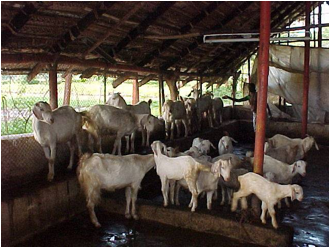
|
||||||||||||||||||||||||||||||||
Integrated Farming System with goats and sheep |
||||||||||||||||||||||||||||||||
Components of integrated farming
Sheep farming in Integrated Farming suitable for wetland: In one acre of land goats can grow up to 30 to 35 numbers. The forage crops of cumbu Napier CO-4 (40 cents), Hedge lucerne - (30 cents), fodder sorghum CO.F.S. 29 - (30 cents) these crops can ensure supply of fodder throughout the year. In this CO 4 grass is high forage yielding one. It had high tillering capacity, lean stems with more leaves, easy palatability and not having spines attracts sheep. Further, it has easy digestibility. The intercrop CO-4 variety are fed into small pieces will increase the body growth rate. Buffel grass varieties viz., blue, white and black can withstand the drought and weed infestation. This kind of grass was suitable for pastures. These grasses cultivated with legume fodder such as Stylo in 3:1 proportion in dryland pastures would increase the productivity of goats. Produced forages are cut in to small pieces and fed to the sheeps. Generally, sheep produce three lambs in two years. This will give more profitable than other livestock. Moreover, green fodder given to goats about 2 to 3 kg per day would be sufficient. Goat rearing in dryland IFS:
In integrated farming, suitable for dryland of 1 hectare land with crop cultivation and goat rearing (20 females: 1 male) by doing this, three times production, net profit and increasing employment chances. From 20 sheeps we can get 45 lambs in a year. Moreover, from sheep manure we get 200 kg N, 106 kg P and 91 kg K. it also gives 40 to 50 thousand rupees additional income. In our country, sheeps are largely dependent on Grazing land because of this sheep’s productivity is low. Solving this problem tree kind fodder leaves, agri related products as daily feed will increase the productivity. Thus groundnut leaves, red gram bran, black gram bran and such as the feeding of the wood leaves like Agathi, Barnyard, neem, Tamarind, Supapul, Desmanthus, Portia, surrogates such as tree leaves Acacia, Kutaivelan, Velikattan and Raintree pods will give required nutrient-rich forage to the sheep. It removes fodder demand, increase meat production leads to getting additional income. During rainy season, sheeps get enough amount of green grass through the pasture. So allow 6 to 8 hours daily for grazing is enough for sheep. During summer (March to August) green grass not available. Therefore, in the Cause of mixed ration (Concentrate) giving to sheep’s is necessary. In this concentrated fodder include cereals, cakes, rice or wheat bran, mineral Mixture and normal saline. Usually for sheep’s, groundnut cake, sesame or mixed soya cake mixed with mixture fodder may fed to the sheep. During non-availability of mixture fodder, red gram bran, black gram bran, bengal gram brans to be given as fodder.
Agroforestry and kennel method of goat rearing
Construction of Shed
Integrated sheep rearing: Sheep farming in dry lands under integrated farming system is profitable business. In these lands crop cultivation with fodder trees are fed to the sheep. It has rich in proteins and minerals. These include Agathi, neemSupapaul, Acacia sp, kalyanamurungai, Gliricidia and Raintree are important one. Tree leaves are rich source of nutrients than other fodder. Instead of giving tree fodder alone it can be mixed with cereal or legume fodder will reduce the feed cost of fodder sorghum and increase the productivity of sheep. It's not just giving maravakait tivanankalait separately mixed with cereal grains or forages pulvakait, sheep concentrate mixture of corn, cut through the green, can increase productivity. Sheep farming income depends on the ability of production of lamb. To make the sheep farming profitable one breeding management practices to be followed in right time. Goats are usually produces their offspring’s around the year and also get into lactation 60 to 90 days after give berth. Tamil Nadu is categorized according to three oestrus periods. Goats become enter into estrus period during March to April give birth to lamb in July to August. From the beginning of June, due to start of south-west monsoon both sheep and lamb got good fodder. The sheep had good milk production capacity increase the growth of lamb.
Therefore, future agriculture depends on planned farming of marginal and small farmers. Farm holders according to their resource availability if integrated farming system is followed they can improve their livelihoods and standard of living. |
||||||||||||||||||||||||||||||||
| Home | Seasons & Varieties | Tillage | Nutrient Management | Irrigation Management | Weed Management | Crop Protection | Cost of Cultivation | Photobank| Disclaimer
© All Rights Reserved. TNAU-2016. |
||||||||||||||||||||||||||||||||
 Production of agricultural crops, vary in response to changes of the seasons. In the recent period stable income of agricultural crops has become unstable. Redressing these by integrating crops with agro-based industries like livestock farming is essential. In today's environment, increasing demand for meat in rural and urban areas can help small and part-time farmers earn good profits by trading with the goat and sheep farming. Because of less investment and maintenance costs for shed, it can be done in coordination with agriculture crops.
Production of agricultural crops, vary in response to changes of the seasons. In the recent period stable income of agricultural crops has become unstable. Redressing these by integrating crops with agro-based industries like livestock farming is essential. In today's environment, increasing demand for meat in rural and urban areas can help small and part-time farmers earn good profits by trading with the goat and sheep farming. Because of less investment and maintenance costs for shed, it can be done in coordination with agriculture crops.